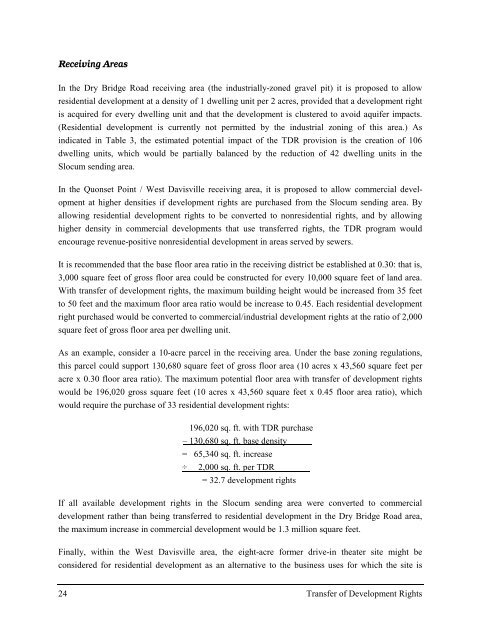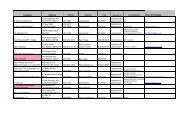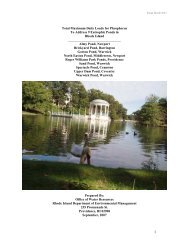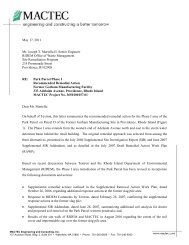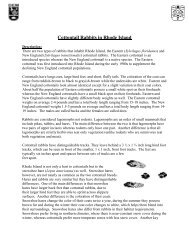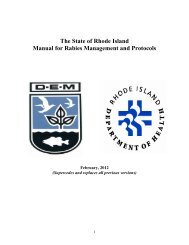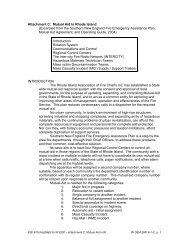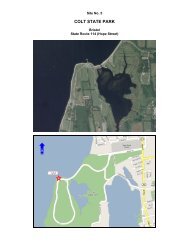Transfer of Development Rights Report - Rhode Island Department ...
Transfer of Development Rights Report - Rhode Island Department ...
Transfer of Development Rights Report - Rhode Island Department ...
Create successful ePaper yourself
Turn your PDF publications into a flip-book with our unique Google optimized e-Paper software.
Receiving Areas<br />
In the Dry Bridge Road receiving area (the industrially-zoned gravel pit) it is proposed to allow<br />
residential development at a density <strong>of</strong> 1 dwelling unit per 2 acres, provided that a development right<br />
is acquired for every dwelling unit and that the development is clustered to avoid aquifer impacts.<br />
(Residential development is currently not permitted by the industrial zoning <strong>of</strong> this area.) As<br />
indicated in Table 3, the estimated potential impact <strong>of</strong> the TDR provision is the creation <strong>of</strong> 106<br />
dwelling units, which would be partially balanced by the reduction <strong>of</strong> 42 dwelling units in the<br />
Slocum sending area.<br />
In the Quonset Point / West Davisville receiving area, it is proposed to allow commercial development<br />
at higher densities if development rights are purchased from the Slocum sending area. By<br />
allowing residential development rights to be converted to nonresidential rights, and by allowing<br />
higher density in commercial developments that use transferred rights, the TDR program would<br />
encourage revenue-positive nonresidential development in areas served by sewers.<br />
It is recommended that the base floor area ratio in the receiving district be established at 0.30: that is,<br />
3,000 square feet <strong>of</strong> gross floor area could be constructed for every 10,000 square feet <strong>of</strong> land area.<br />
With transfer <strong>of</strong> development rights, the maximum building height would be increased from 35 feet<br />
to 50 feet and the maximum floor area ratio would be increase to 0.45. Each residential development<br />
right purchased would be converted to commercial/industrial development rights at the ratio <strong>of</strong> 2,000<br />
square feet <strong>of</strong> gross floor area per dwelling unit.<br />
As an example, consider a 10-acre parcel in the receiving area. Under the base zoning regulations,<br />
this parcel could support 130,680 square feet <strong>of</strong> gross floor area (10 acres x 43,560 square feet per<br />
acre x 0.30 floor area ratio). The maximum potential floor area with transfer <strong>of</strong> development rights<br />
would be 196,020 gross square feet (10 acres x 43,560 square feet x 0.45 floor area ratio), which<br />
would require the purchase <strong>of</strong> 33 residential development rights:<br />
196,020 sq. ft. with TDR purchase<br />
– 130,680 sq. ft. base density<br />
= 65,340 sq. ft. increase<br />
÷ 2,000 sq. ft. per TDR<br />
= 32.7 development rights<br />
If all available development rights in the Slocum sending area were converted to commercial<br />
development rather than being transferred to residential development in the Dry Bridge Road area,<br />
the maximum increase in commercial development would be 1.3 million square feet.<br />
Finally, within the West Davisville area, the eight-acre former drive-in theater site might be<br />
considered for residential development as an alternative to the business uses for which the site is<br />
24 <strong>Transfer</strong> <strong>of</strong> <strong>Development</strong> <strong>Rights</strong>


